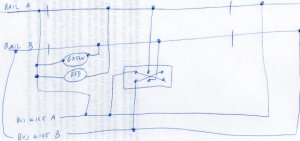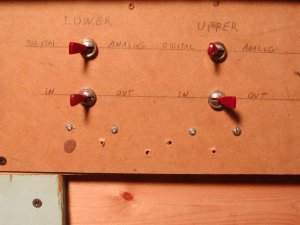Here's a picture of a panel almost as crude as my drawing. I built it to allow operation of analog locos on my bottom level mainline. Basically the layout on the bottom level consists of a double track mainline with staging reverse loops at each end. One end has three reverse blocks, the other 5. I made one of the blocks at each end able to bypass the auto reverser (the digital/analog switch) When in analog, the other switch is in the circuit, and aligns the polarity of the reverse block with either the inbound or outbound end. This is what I referred to in my last post, using the handle of a toggle to indicate which way the polarity is set. Wouldn't have been hard to install lights or leds but I felt it wasn't needed. BTW, after using the toggles initially, they haven't been used in years, I don't want to throw toggles! I just don't run analog except to test prior to decoder installation, so don't need to run them into the reverse blocks. Hope some of this helps.
Gary



